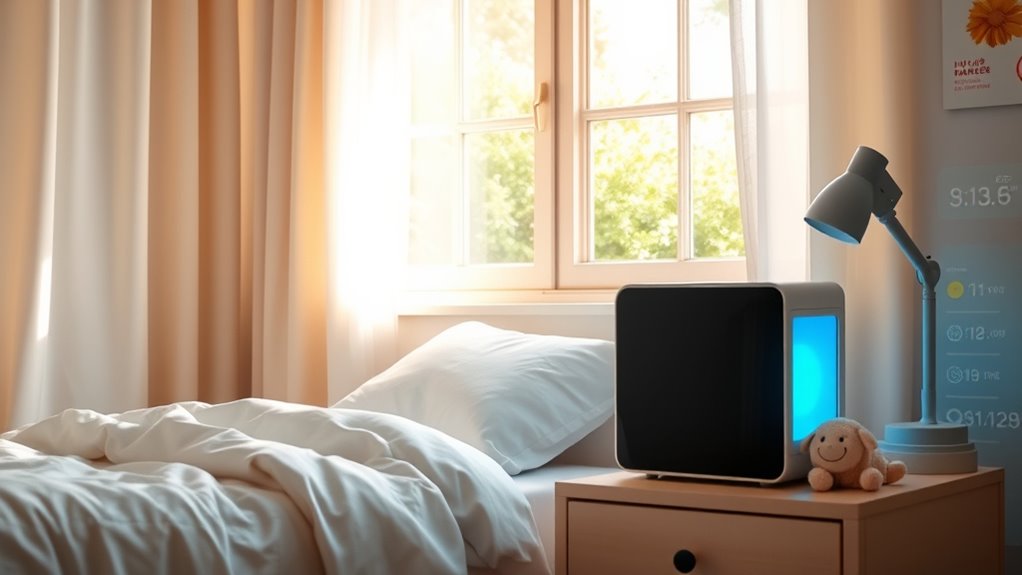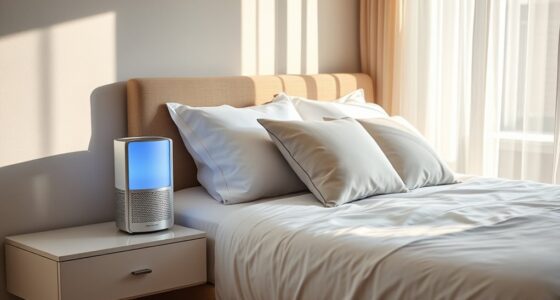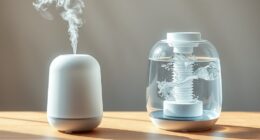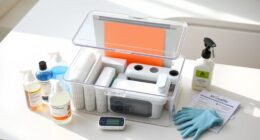To protect children with asthma, adjust your home’s air settings by controlling humidity below 50% with dehumidifiers, using allergen-proof covers, and keeping bedding clean. Increase ventilation during good outdoor conditions and use air purifiers with high-efficiency filters to reduce airborne allergens. Always monitor indoor air quality with a reliable device to detect issues early, and take swift action like closing windows or boosting ventilation when needed. Learn more to create the safest environment for your child.
Key Takeaways
- Use air quality monitors to track pollutants and adjust ventilation or air purifier settings accordingly.
- Keep indoor humidity below 50% to prevent mold growth, which can trigger asthma attacks.
- Use allergen-proof mattress and pillow covers to reduce dust mite exposure.
- Ensure proper ventilation in high-moisture areas with exhaust fans to limit mold and mildew.
- Keep windows closed during high pollen or pollution seasons and rely on air purifiers for cleaner indoor air.
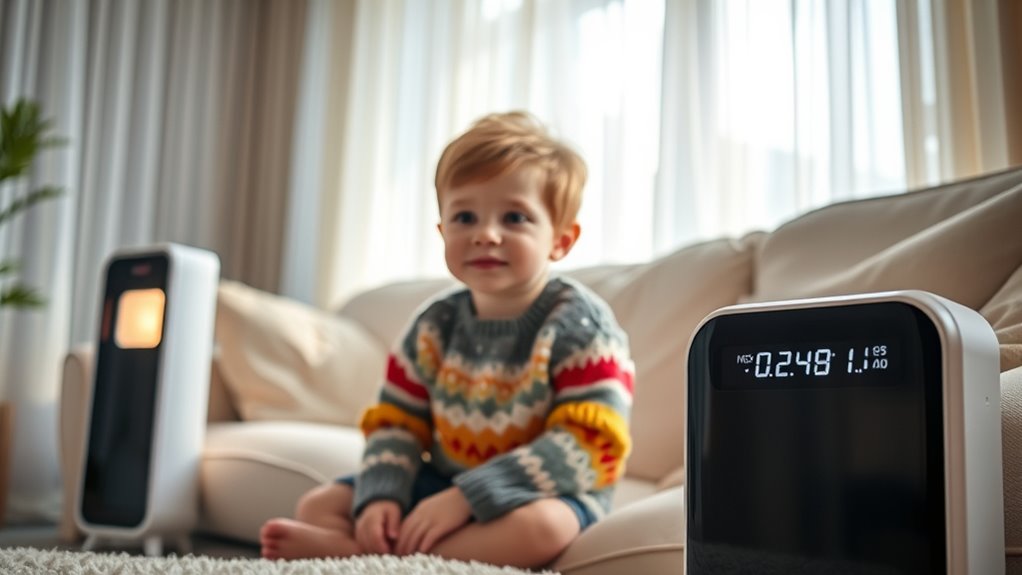
Asthma can pose serious challenges for children, but with the right precautions, you can substantially reduce their risk of attacks and ensure they stay safe. One key step is managing indoor allergens, which are common triggers that can worsen asthma symptoms. These allergens include dust mites, pet dander, mold, and cockroach droppings. To minimize exposure, you should regularly clean and vacuum your home using a HEPA filter vacuum, wash bedding weekly in hot water, and keep pets out of bedrooms to reduce dander. Controlling humidity levels also helps prevent mold growth, so aim to keep indoor humidity below 50%. Using allergen-proof mattress and pillow covers can create an additional barrier against dust mites. These simple actions can markedly lessen your child’s exposure to indoor allergens, helping to keep their asthma under control.
Another essential aspect is air quality monitoring. Installing a reliable air quality monitor in your home allows you to keep track of pollutants, humidity, and airborne allergens in real-time. This technology helps you identify potential issues before they become severe, such as elevated levels of dust, mold spores, or volatile organic compounds (VOCs) from household products. When the monitor detects poor air quality, you can take immediate steps—like increasing ventilation, turning on an air purifier, or reducing sources of indoor pollution. These proactive measures improve overall air quality, which is vital in preventing asthma attacks. Regularly checking air quality data empowers you to make informed decisions and maintain a healthier living environment.
Adjusting your home’s air settings also involves optimizing ventilation. Use exhaust fans in the kitchen and bathroom to remove moisture and reduce mold risk. Consider installing an HVAC system with high-efficiency filters that can trap airborne allergens and pollutants. When weather permits, open windows to increase fresh air circulation, but only if outdoor air quality is good. During times of high pollution or pollen, keep windows closed and rely on your air purifier and air quality monitor to maintain safe indoor conditions. These adjustments help create an environment where your child can breathe more easily and with fewer triggers.
Frequently Asked Questions
How Can I Detect Early Signs of Asthma Attacks at Home?
You can detect early signs of asthma attacks at home by paying close attention to your child’s early symptom awareness, such as coughing, wheezing, or shortness of breath. Monitor their breathing patterns regularly, noting any unusual tightness or difficulty. If you notice these signs, act quickly to manage their symptoms and consult their healthcare provider. Early detection helps prevent severe attacks and keeps your child safer.
Are There Specific Air Purifiers Recommended for Children With Asthma?
You should look for air purifiers with HEPA filters, as they effectively trap airborne allergens and asthma triggers. Brands like Blueair, Honeywell, and Winix are highly recommended for children with asthma. Make certain the purifier is appropriately sized for your child’s room, and run it continuously to maintain clean air. Regularly replace filters to maximize efficiency, creating a safer environment that minimizes asthma flare-ups.
How Often Should I Replace or Clean Air Filters in My Home?
You should replace or clean your air filters every 1 to 3 months to maintain ideal indoor air quality. Regular air filter maintenance is essential, especially if you have children with asthma, as it helps reduce airborne irritants. Check your filters monthly, especially during high pollen seasons or if you notice dust buildup. Keeping filters clean guarantees better airflow and healthier indoor air, reducing asthma triggers in your home.
What Indoor Plants Are Safe and Beneficial for Children With Asthma?
Did you know that some indoor plants can improve air quality and are safe for children with asthma? Choose non-toxic plants like spider plants or Boston ferns, which are also low maintenance greenery. These plants help filter indoor pollutants and add humidity, reducing asthma triggers. Always verify plant safety and avoid those with toxic sap or strong fragrances. Incorporating these easy-care plants creates a healthier, calming environment for your child.
Can Humidity Levels Affect My Child’s Asthma, and What Is Ideal?
Yes, humidity control considerably impacts your child’s asthma. Too high humidity promotes mold and dust mites, while low humidity can dry airways, triggering attacks. The ideal air quality maintains humidity levels between 30-50%. Use a humidifier or dehumidifier as needed to keep levels steady, ensuring your child’s environment stays comfortable and safe. Regular monitoring helps prevent asthma flare-ups and supports overall respiratory health.
Conclusion
By adjusting your home’s air settings, you can considerably improve your child’s asthma control. Did you know that indoor air quality can be up to five times worse than outdoor air? Taking simple steps like using air purifiers and maintaining proper humidity levels can make a big difference. You have the power to create a safer, healthier environment—so your child can breathe easier and enjoy life to the fullest.
